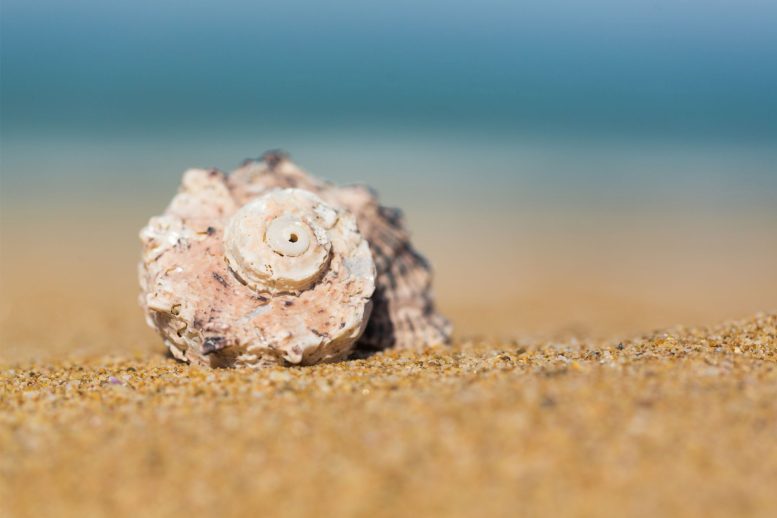
Many organisms, including mollusks, produce minerals like nacre through complex processes involving the extraction of calcium and carbonate ions, with the formation pathway and role of amorphous calcium carbonate (ACC) being key areas of research. A study has identified two chemical environments within ACC particles, offering insights into biomineralization and potential applications in materials science.
How do living organisms produce minerals – for example, for their shells? Researchers have come one step closer to answering this mystery.
Many organisms can produce minerals or mineralized tissue. A famous example is the nacre, which is used in jewelry because of its iridescent colors. Chemically speaking, its formation begins with a mollusk extracting calcium and carbonate ions from water. However, the exact processes and conditions that lead to nacre, a composite of biopolymers and platelets of crystalline calcium carbonate, are the subject of intense debate among experts, and different theories exist.
Researchers do agree that non-crystalline intermediates, such as amorphous calcium carbonate (ACC), play a crucial role in biomineralization. Lobsters and other crustaceans, for example, keep a supply of ACC in their stomachs, which they use to build a new shell after molting. In a recent study published in Nature Communications, researchers from the University of Konstanz and Leibniz University Hannover have now succeeded in deciphering the formation pathway of ACC.
A combination of advanced methods
The researchers led by Denis Gebauer (Leibniz University Hannover) and Guinevere Mathies (University of Konstanz) took advantage of the fact that ACC can be synthesized not only by living organisms, but also in the laboratory. Using advanced methods such as magic-angle spinning nuclear magnetic resonance (MAS NMR) spectroscopy, they analyzed tiny ACC particles to determine their structure. “We struggled to interpret the spectra of ACC. They suggested dynamics, that we were unable to model at first,” says Mathies.
An important clue was provided by the colleagues from Leibniz University Hannover. Maxim Gindele of the Gebauer group showed that ACC conducts electricity. Since ACC particles are very fragile and only tens of nanometres in size (around a 1,000th of the thickness of a human hair), this was not as easy as sticking two leads in. Instead, the measurements were carried out using conductivity atomic force microscopy (C-AFM), in which ACC particles on a flat surface are detected by a minuscule cantilever scanning the surface and visualized with the help of a laser beam. When the cantilever is placed on one of the nanoparticles, a current is passed through its tip to measure the conductivity.
Two different environments
Informed by the observation of conductivity, Sanjay Vinod Kumar of the Mathies group performed further MAS NMR experiments aimed at probing dynamics. They indicated two distinct chemical environments in the ACC particles. In the first environment, the water molecules are embedded in rigid calcium carbonate and can only undergo 180-degree flips. The second environment consists of water molecules undergoing slow tumbling and translation, with dissolved hydroxide ions. “The remaining challenge was to reconcile the two environments with the observed conductivity. Solid salts are insulators and therefore the second, mobile environment had to play a role,” says Mathies. In the new model, the mobile water molecules form a network through the ACC nanoparticles. The dissolved hydroxide ions carry the charge.
The researchers can also account for the formation of the two chemical environments: in water, calcium and carbonate ions tend to stick together and form dynamic assemblies called pre-nucleation clusters. The clusters can undergo phase separation and form dense, liquid droplets, which in turn merge into larger aggregations – similar to how soap bubbles coalesce. “The rigid, less mobile environment arises from the core of the dense, liquid nanodroplets. The network of mobile water molecules, on the other hand, remains from the imperfect coalescence of the droplet surfaces during dehydration towards solid ACC,” explains Gebauer.
These results are a significant step towards a structural model for ACC. At the same time, they provide solid evidence that mineralization starts with pre-nucleation clusters. “This not only brings us closer to understanding the secret of biomineralization, but can also have applications in the development of cementitious materials that bind carbon dioxide and, since we now know that ACC is a conductor, in electrochemical devices,” concludes Mathies.
Reference: “Colloidal pathways of amorphous calcium carbonate formation lead to distinct water environments and conductivity” by Maxim B. Gindele, Sanjay Vinod-Kumar, Johannes Rochau, Daniel Boemke, Eduard Groß, Venkata SubbaRao Redrouthu, Denis Gebauer and Guinevere Mathies, 2 January 2024, Nature Communications.
DOI: 10.1038/s41467-023-44381-x
>>> Read full article>>>
Copyright for syndicated content belongs to the linked Source : SciTechDaily – https://scitechdaily.com/how-do-living-organisms-produce-minerals-like-shells-scientists-unlock-the-secrets-of-biomineralization/